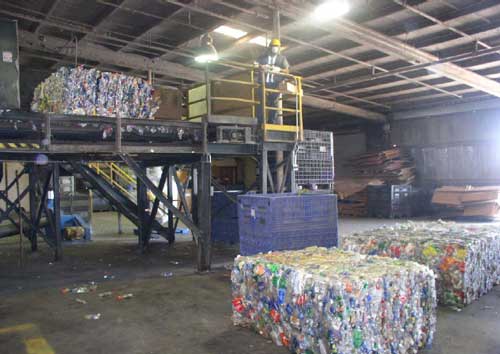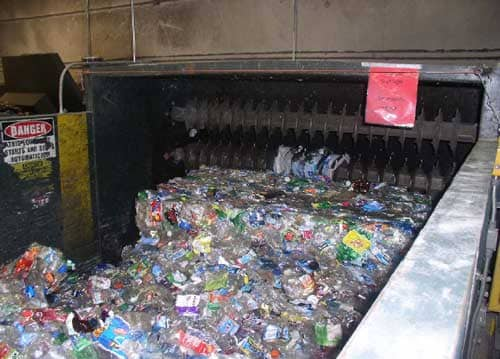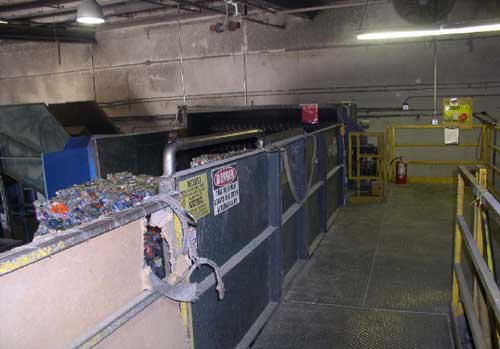Machine Operator in a Plastic Recycling Facility Dies After Being Caught in a Bale Breaker Machine.
California Case Report: 08CA007
Summary
A machine operator died after being caught in the blades of a plastic bottle bale breaker. The victim was attempting to kick plastic bottles into the blades of the bale breaker when his leg caught on the rotating blades of the bale breaker. There were no safety interlocks or protective guarding to prevent workers from entering the conveyor area while the machine was running. The CA/FACE investigator determined that, in order to prevent future occurrences, employers, as part of their Injury and Illness Prevention Program (IIPP) should:
- Collaborate with bale breaker manufacturers on the design and installation of safety features to keep employees away from moving parts.
Introduction
On July 18, 2008, at approximately 3:30 p.m., a 41-year-old machine operator died when he was caught in the blades of a plastic bottle bale breaker machine. The CA/FACE investigator was notified of this incident on July 24, 2008, by the Los Angeles District Office of Division of Occupational Safety and Health (Cal/OSHA). On October 2, 2008, the CA/FACE investigator inspected the incident site and interviewed the owner of the company, supervisors, and two coworkers of the victim.
The victim’s employer was a polyethylene terephthalate (PET) recycling company that had been in business for 12 years and had approximately 100 employees. The victim had been employed with the company for about eight months as a bale breaker machine operator. The victim was born in the United States and was a high school graduate.
The employer of the victim had a safety program and a written IIPP. There were written safe work procedures for all tasks performed, and they had a safety committee that met twice per year. The company had a specific written policy for handling material misfeeds in the bale breaker. Safety meetings were held monthly and were documented. Training was conducted in a classroom setting with factory representatives and company supervisors giving specific instructions on the safe operation of the machine an employee would be operating. Employees were given on-the-job-training (OJT) on the machines, and their proficiency was measured through demonstration of skills observed by their supervisor. The victim had been trained and his work procedure observed daily by his immediate supervisor and the owner of the company. The victim had received training in handling bale breaker material misfeeds and had successfully passed his evaluation.
Investigation
The site of the incident was a bale breaker machine within a plastic bottle recycling facility (Exhibit 1). Plastic bottles were received at the company warehouse in bales from various vendors, and the bale breaker was used to separate the bottles from each other so that they could be further processed. The bale breaker was approximately 9 ft. high by 5 ft. wide by 30 ft. long. There was a twenty foot long conveyor belt that carried the bales to rapidly spinning blades that tore apart each bale and sent the individual bottles onto the next portion of the recycling process. The breaker had been manufactured by the Bulk Handling Systems (BHS). The bale breaker machine had stairs that led to a catwalk along one side of the conveyor belt. The conveyor belt on the bale breaker was enclosed with a hinged gate at the beginning of the conveyor belt to gain access to that area. The opening on the outside portion of the conveyor belt allowed a forklift to raise the bales of plastic bottles onto it. A forklift placed the bales on the conveyer belt, and the bales fed into rotating blades that broke apart the compressed bottles. During the bale breaking process, some bottles would break loose from the bale, begin to bounce off the blades, and fail to pass through the breaker into the next portion of the process. If bottles from the bales failed to properly feed into the blades, the company’s standard procedure was to stop the blades and reverse the direction of the conveyor belt until the misfed bottles moved away from the blades then restart the blades and conveyor and again try to feed the bottles into the breaker blades. This entire procedure was performed using controls safely away from the conveyor and blades.
On the day of the incident, the victim and his co-worker were standing on the bale breaker catwalk (Exhibit 3) and saw a small portion of a bale not properly feeding into the blades. The co-worker left the victim to address the problem and started down the catwalk stairs. According to the victim’s co-worker, the victim entered the conveyor belt area while the machine was still running, and used his foot to kick the stuck bale into the blades. The victim’s foot was caught by the rotating blades and pulled his body into the machine. The co-worker heard the victim cry for assistance and shut the machine off at the machine control panel located at the top of the stairs. The victim could not be removed from the blades by the coworker. Emergency services were summoned by office personnel after the co-worker ran to the office for help and then returned to stay with the victim until help arrived. Once the victim was removed from the bale breaker machine he became unresponsive, and subsequently died after being transported to a local emergency room.
Cause of Death
The cause of death, according to the death certificate was multiple sharp and blunt injuries.
Recommendations/Discussion
Recommendation #1: Employers should collaborate with bale breaker manufacturers on the design and installation of safety features to keep employees away from moving parts.
Discussion: In this incident, the victim was able to gain access to moving portions of the bale breaker. The design of the conveyor and bale breaker had physical barriers but they did not prevent access to moving parts. There were also no safety interlocks which could have shut down the machine in case a worker entered an unsafe area. By working and collaborating with machine manufacturers, additional safety devices could be added to the machine that would assure employees safety when working with machines that require an employee to be in close proximity to moving parts.
Reference
- California Code of Regulations: Vol. 9, Title 8, Subchapter 7. General Industry Safety Orders Group 3. General Plant Equipment and Special Operations Article 15. Vats, Pans, Bins, Bunkers, Hoppers, and Similar Containers and Vessels §3482. Bulk Storage of Loose Material.
- Group 6. Power Transmission Equipment, Prime Movers, Machines and Machine Parts Article 41. Prime Movers and Machinery §4002. Moving Parts of Machinery or Equipment.
- Group 8. Points of Operation and Other Hazardous Parts of Machinery Article 54. Scope and General Definitions §4186. Maintenance and Use of Point of Operation Tools and Guards.
Exhibits

|
 |
|
Exhibit 2. The bales of plastic bottles being fed into the |
 |
|
Exhibit 3. The catwalk used to gain access to the bale breaker machine. |
California Fatality Assessment and Control Evaluation (FACE) Project
The California Department of Public Health, in cooperation with the Public Health Institute and the National Institute for Occupational Safety and Health (NIOSH), conducts investigations of work-related fatalities. The goal of the CA/FACE program is to prevent fatal work injuries. CA/FACE aims to achieve this goal by studying the work environment, the worker, the task the worker was performing, the tools the worker was using, the energy exchange resulting in fatal injury, and the role of management in controlling how these factors interact. NIOSH-funded, State-based FACE programs include: California, Iowa, Kentucky, Massachusetts, Michigan, New Jersey, New York, Oregon, and Washington.
To contact California State FACE program personnel regarding State-based FACE reports, please use information listed on the Contact Sheet on the NIOSH FACE web site. Please contact In-house FACE program personnel regarding In-house FACE reports and to gain assistance when State-FACE program personnel cannot be reached.
